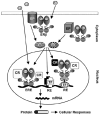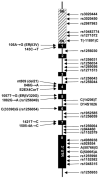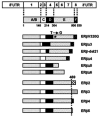Do Estrogen Receptor beta Polymorphisms Play A Role in the Pharmacogenetics of Estrogen Signaling?
- PMID: 19337586
- PMCID: PMC2662734
- DOI: 10.2174/187569208786733820
Do Estrogen Receptor beta Polymorphisms Play A Role in the Pharmacogenetics of Estrogen Signaling?
Abstract
Estrogen hormones play critical roles in the regulation of many tissue functions. The effects of estrogens are primarily mediated by the estrogen receptors (ER) alpha and beta. ERs are ligand-activated transcription factors that regulate a complex array of genomic events that orchestrate cellular growth, differentiation and death. Although many factors contribute to their etiology, estrogens are thought to be the primary agents for the development and/or progression of target tissue malignancies. Many of the current modalities for the treatment of estrogen target tissue malignancies are based on agents with diverse pharmacology that alter or prevent ER functions by acting as estrogen competitors. Although these compounds have been successfully used in clinical settings, the efficacy of treatment shows variability. An increasing body of evidence implicates ERalpha polymorphisms as one of the contributory factors for differential responses to estrogen competitors. This review aims to highlight the recent findings on polymorphisms of the lately identified ERbeta in order to provide a functional perspective with potential pharmacogenomic implications.
Conflict of interest statement
Figures




Similar articles
-
Molecular mechanisms of estrogen action: selective ligands and receptor pharmacology.J Steroid Biochem Mol Biol. 2000 Nov 30;74(5):279-85. doi: 10.1016/s0960-0760(00)00104-7. J Steroid Biochem Mol Biol. 2000. PMID: 11162936 Review.
-
Estrogen signaling: a subtle balance between ER alpha and ER beta.Mol Interv. 2003 Aug;3(5):281-92. doi: 10.1124/mi.3.5.281. Mol Interv. 2003. PMID: 14993442 Review.
-
Single-chain estrogen receptors (ERs) reveal that the ERalpha/beta heterodimer emulates functions of the ERalpha dimer in genomic estrogen signaling pathways.Mol Cell Biol. 2004 Sep;24(17):7681-94. doi: 10.1128/MCB.24.17.7681-7694.2004. Mol Cell Biol. 2004. PMID: 15314175 Free PMC article.
-
Molecular basis of therapeutic strategies for breast cancer.Curr Drug Targets Immune Endocr Metabol Disord. 2005 Dec;5(4):379-96. doi: 10.2174/156800805774912944. Curr Drug Targets Immune Endocr Metabol Disord. 2005. PMID: 16375692 Review.
-
Estrogen receptors: selective ligands, partners, and distinctive pharmacology.Recent Prog Horm Res. 2000;55:163-93; discussion 194-5. Recent Prog Horm Res. 2000. PMID: 11036937 Review.
Cited by
-
Investigating the rate of different ovarian response in in vitro fertilization cycles based on estrogen receptor beta +1730 polymorphism: A cross-sectional study.Int J Reprod Biomed. 2020 Jul 22;18(7):509-516. doi: 10.18502/ijrm.v13i7.7368. eCollection 2020 Jul. Int J Reprod Biomed. 2020. PMID: 32803202 Free PMC article.
-
The potential health effects of dietary phytoestrogens.Br J Pharmacol. 2017 Jun;174(11):1263-1280. doi: 10.1111/bph.13622. Epub 2016 Oct 20. Br J Pharmacol. 2017. PMID: 27723080 Free PMC article. Review.
-
Association between single nucleotide polymorphism of the CYP19A1 and ESR2 genes and endometriosis.Arch Gynecol Obstet. 2021 Aug;304(2):439-445. doi: 10.1007/s00404-021-06051-5. Epub 2021 Apr 7. Arch Gynecol Obstet. 2021. PMID: 33825969
-
The Genetic Background of Endometriosis: Can ESR2 and CYP19A1 Genes Be a Potential Risk Factor for Its Development?Int J Mol Sci. 2020 Nov 3;21(21):8235. doi: 10.3390/ijms21218235. Int J Mol Sci. 2020. PMID: 33153202 Free PMC article. Review.
References
-
- Ali S, Coombes RC. Endocrine-responsive breast cancer and strategies for combating resistance. Nat Rev Cancer. 2002;2:101–112. - PubMed
-
- Almeida S, Franken N, Zandona MR, Osorio-Wender MC, Hutz MH. Estrogen receptor 2 and progesterone receptor gene polymorphisms and lipid levels in women with different hormonal status. Pharmacogenomics J. 2005;5:30–34. - PubMed
-
- Ansonoff MA, Etgen AM. Estradiol elevates protein kinase C catalytic activity in the preoptic area of female rats. Endocrinology. 1998;139:3050–3056. - PubMed
-
- Arko B, Prezelj J, Komel R, Kocijancic A, Marc J. No major effect of estrogen receptor β gene RsaI polymorphism on bone mineral density and response to alendronate therapy in post-menopausal osteoporosis. J Steroid Biochem Mol Biol. 2002;81:147–152. - PubMed
-
- Aschim EL, Giwercman A, Stahl O, Eberhard J, Cwikiel M, Nordenskjold A, Haugen TB, Grotmol T, Giwercman YL. The RsaI polymorphism in the estrogen receptor-β gene is associated with male infertility. J Clin Endocrinol Metab. 2005;90:5343–5348. - PubMed
Grants and funding
LinkOut - more resources
Full Text Sources
